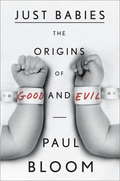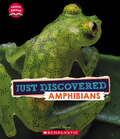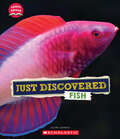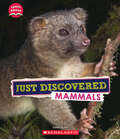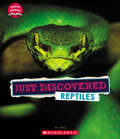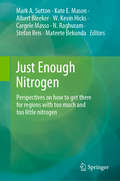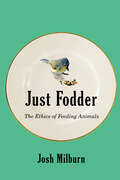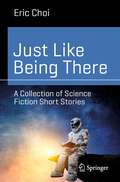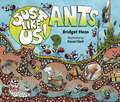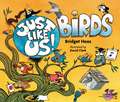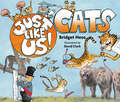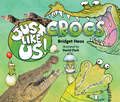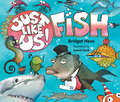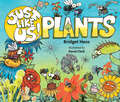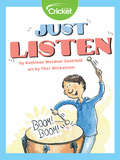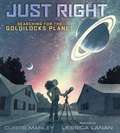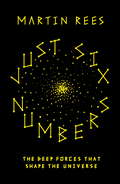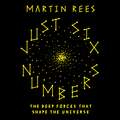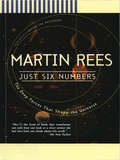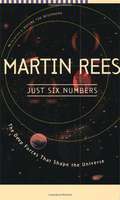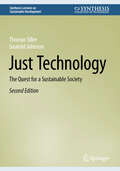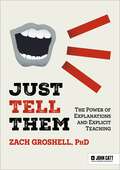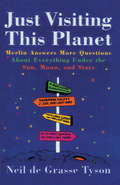- Table View
- List View
Just Babies: The Origins of Good and Evil
by Paul Bloom<P>A leading cognitive scientist argues that a deep sense of good and evil is bred in the bone. From John Locke to Sigmund Freud, philosophers and psychologists have long believed that we begin life as blank moral slates. Many of us take for granted that babies are born selfish and that it is the role of society--and especially parents--to transform them from little sociopaths into civilized beings. <P>In Just Babies, Paul Bloom argues that humans are in fact hardwired with a sense of morality. Drawing on groundbreaking research at Yale, Bloom demonstrates that, even before they can speak or walk, babies judge the goodness and badness of others' actions; feel empathy and compassion; act to soothe those in distress; and have a rudimentary sense of justice. <P>Still, this innate morality is limited, sometimes tragically. We are naturally hostile to strangers, prone to parochialism and bigotry. Bringing together insights from psychology, behavioral economics, evolutionary biology, and philosophy, Bloom explores how we have come to surpass these limitations. <P> Along the way, he examines the morality of chimpanzees, violent psychopaths, religious extremists, and Ivy League professors, and explores our often puzzling moral feelings about sex, politics, religion, and race. In his analysis of the morality of children and adults, Bloom rejects the fashionable view that our moral decisions are driven mainly by gut feelings and unconscious biases. <P>Just as reason has driven our great scientific discoveries, he argues, it is reason and deliberation that makes possible our moral discoveries, such as the wrongness of slavery. Ultimately, it is through our imagination, our compassion, and our uniquely human capacity for rational thought that we can transcend the primitive sense of morality we were born with, becoming more than just babies. <P>Paul Bloom has a gift for bringing abstract ideas to life, moving seamlessly from Darwin, Herodotus, and Adam Smith to The Princess Bride, Hannibal Lecter, and Louis C.K. Vivid, witty, and intellectually probing, Just Babies offers a radical new perspective on our moral lives. <P><b>A New York Times Bestseller</b>
Just Discovered Amphibians (Learn About)
by Danielle DenegaLet's learn all about newly discovered animals!Have you ever seen a glass frog or a pumpkin toadlet? Now you can! With amazing photos and lively text, this book explores five new species of amphibians. Get ready to learn all about how, when, and where these animals were discovered!ABOUT THE SERIES:Did you know scientists discover thousands of new species every year? Some are even named after things in popular culture like the Wakanda fish (Black Panther) and the Salazar's pit viper (Harry Potter). This vibrant new set of Learn About books gives readers a close-up look into five of the most fascinating new species of amphibians, fish, mammals, and reptiles that have been found on Earth in the past few years. Each book explores how, where, and when they were found, along with their habitat, diet, and survival skills. Packed with photographs and fun facts, readers will learn all about these exciting new species in the natural world.
Just Discovered Fish (Learn About)
by Claire CaprioliLet's learn all about newly discovered animals!Have you ever seen a Wakanda fish or a blue snailfish? Now you can! With amazing photos and lively text, this book explores five new species of fish. Get ready to learn all about how, when, and where these animals were discovered!ABOUT THE SERIES:Did you know scientists discover thousands of new species every year? Some are even named after things in popular culture like the Wakanda fish (Black Panther) and the Salazar's pit viper (Harry Potter). This vibrant new set of Learn About books gives readers a close-up look into five of the most fascinating new species of amphibians, fish, mammals, and reptiles that have been found on Earth in the past few years. Each book explores how, where, and when they were found, along with their habitat, diet, and survival skills. Packed with photographs and fun facts, readers will learn all about these exciting new species in the natural world.
Just Discovered Mammals (Learn About)
by Sonia W. BlackLet's learn all about newly discovered animals!Have you ever seen a spotted skunk or an orange bat? Now you can! With amazing photos and lively text, this book explores five new species of mammals. Get ready to learn all about how, when, and where these animals were discovered!ABOUT THE SERIES:Did you know scientists discover thousands of new species every year? Some are even named after things in popular culture like the Wakanda fish (Black Panther) and the Salazar's pit viper (Harry Potter). This vibrant new set of Learn About books gives readers a close-up look into five of the most fascinating new species of amphibians, fish, mammals, and reptiles that have been found on Earth in the past few years. Each book explores how, where, and when they were found, along with their habitat, diet, and survival skills. Packed with photographs and fun facts, readers will learn all about these exciting new species in the natural world.
Just Discovered Reptiles (Learn About)
by Jay LeslieLet's learn all about newly discovered animals!Have you ever seen a Salazar's pit viper or a nano chameleon? Now you can! With amazing photos and lively text, this book explores five new species of reptiles. Get ready to learn all about how, when, and where these animals were discovered!ABOUT THE SERIES:Did you know scientists discover thousands of new species every year? Some are even named after things in popular culture like the Wakanda fish (Black Panther) and the Salazar's pit viper (Harry Potter). This vibrant new set of Learn About books gives readers a close-up look into five of the most fascinating new species of amphibians, fish, mammals, and reptiles that have been found on Earth in the past few years. Each book explores how, where, and when they were found, along with their habitat, diet, and survival skills. Packed with photographs and fun facts, readers will learn all about these exciting new species in the natural world.
Just Enough Nitrogen: Perspectives on how to get there for regions with too much and too little nitrogen
by Mark A. Sutton Albert Bleeker Stefan Reis Kate E. Mason W. Kevin Hicks Cargele Masso N. Raghuram Mateete BekundaThis volume provides a unique collection of contributions addressing both the ‘too much’ and ‘too little’ sides of the nitrogen story. Building on analyses started at the 6th International Nitrogen Conference, Kampala, the book explores the idea of ‘just enough nitrogen’: sufficient for sustainable food production, but not so much as to lead to unsustainable pollution and climate problems. The range of nitrogen threats examined, solutions evaluated and science-policy analyses presented here has provided the foundation to agree the ‘Kampala Statement-for-Action on Nitrogen in Africa and Globally,’ as reported in this volume. Humanity today faces unprecedented challenges: How to feed a growing population? How to reduce air pollution, water pollution and climate change? How to handle regional differences in an era of increasing globalization? These questions are at the heart of this edited volume which examines the multi-dimensional nature of the global nitrogen challenge. While humans have massively altered the nitrogen cycle, the consequences have become polarized. Some regions have too much nitrogen, associated with pollution and wasteful use of a valuable resource, while other regions have too little nitrogen, leading to constraints on food production and depletion of soil nutrient stocks. The volume provides a unique collection of contributions addressing both the ‘too much’ and ‘too little’ sides of the nitrogen story. Building on analyses started at the 6th International Nitrogen Conference, Kampala, the book explores the idea of ‘just enough nitrogen’: sufficient for sustainable food production, but not so much as to lead to unsustainable pollution and climate problems. The range of nitrogen threats examined, solutions evaluated and science-policy analyses presented here has provided the foundation to agree the ‘Kampala Statement-for-Action on Nitrogen in Africa and Globally,’ as reported in this volume. Together, the contributions in this book are now informing actions by the International Nitrogen Initiative (INI) in working with the United Nations Environment Programme and others to establish the International Nitrogen Management System (INMS). A key outcome has been to catalyse development of the first Resolution on Sustainable Nitrogen Management, as adopted by the fourth UN Environment Assembly (UNEA/EA.4/Res.14).The work is written for researchers and policy makers and all those interested in seeing how sustainable nitrogen management can contribute to meeting many of the UN Sustainable Development Goals.
Just Fodder: The Ethics of Feeding Animals
by Josh MilburnAnimal lovers who feed meat to other animals are faced with a paradox: perhaps fewer animals would be harmed if they stopped feeding the ones they love. Animal diets do not raise problems merely for individuals. To address environmental crises, health threats, and harm to animals, we must change our food systems and practices. And in these systems, animals, too, are eaters.Moving beyond what humans should eat and whether to count animals as food, Just Fodder answers ethical and political questions arising from thinking about animals as eaters. Josh Milburn begins with practical dilemmas about feeding the animals closest to us, our pets or animal companions. The questions grow more complicated as he considers relationships with more distance – questions about whether and how to feed garden birds, farmland animals who would eat our crops, and wild animals. Milburn evaluates the nature and circumstances of our relationships with animals to generate a novel theory of animal rights.Looking past arguments about what we can and cannot do to other beings, Just Fodder asks what we can, should, and must do for them, laying out a fuller range of our ethical obligations to other animals.
Just Like Being There: A Collection of Science Fiction Short Stories (Science and Fiction)
by Eric ChoiJust Like Being There is the first collection of science fiction stories by award-winning author and aerospace engineer Eric Choi spanning his 25 year writing career. The stories are “hard” science fiction in which some element of engineering or science is so central there would be no story if that element were removed. Story topics include space exploration, artificial intelligence, virtual reality, cryptography, quantum computing, online privacy, mathematics (statistics), neuroscience, psychology, space medicine, extra-terrestrial intelligence, undersea exploration, commercial aviation, and the history of science. A special feature of the book is that each story is followed by an "Afterword" that explains the underlying engineering or science. This collection will entertain and inform all aficionados of science and science fiction.
Just Like Us! Ants (Just Like Us!)
by David Clark Bridget HeosWhat animal farms, builds roads, constructs rafts, and even babysits its younger siblings? ANTS! While they might seem as different from humans as animals can possibly be, we actually have a lot in common with these creepy-crawly insects. From their families to their jobs, their farms to their construction work, ants are a lot like us—though with fascinating twists all their own. Factual and funny—and featuring a dynamic mix of photographs and cartoon illustrations—Just Like Us! Ants will charm even the most reluctant nonfiction readers.
Just Like Us! Birds (Just Like Us!)
by David Clark Bridget HeosWhat animals compose music, decorate their homes, weave, and even give gifts? BIRDS! While they may eat bugs and lay eggs, we actually have a lot in common with these winged creatures. From their parenting to their homemaking, their fishing to their dancing, birds do have lots in common with people—though with fascinating twists all their own. Factual and funny—and featuring a dynamic mix of photographs and cartoon illustrations—Just Like Us! Birds will charm even the most reluctant nonfiction readers.
Just Like Us! Cats (Just Like Us!)
by Bridget HeosGet the facts on some of nature&’s most beloved animals and discover the unexpected ways humans and cats are similar in Just Like Us! Cats. Appealing mix of photographs and cartoon illustrations. What animals are loving parents, great diplomats, and world class CAThletes? CATS! While they may seem as different from us as animals can possibly be, we actually have a lot in common with our feline friends. From their hunting skills to their fondness for nap time, cats are a lot like us—though with fascinating twists all their own. Factual, funny, and featuring a dynamic mix of photographs and cartoon illustrations, Just Like Us! Cats will charm even the most reluctant nonfiction readers.
Just Like Us! Crocs (Just Like Us!)
by Bridget HeosGet the scoop on some of nature&’s most fearsome predators and discover the unexpected ways humans and crocodilians are similar in Just Like Us! Crocs. Appealing mix of photographs and cartoon illustrations. What animals love to bask in the sun, cool off with a quick swim, and don&’t always get along with their siblings? CROCS! While they might seem as different from us as animals can possibly be, we actually have a lot in common with our crocodilian comrades—alligators, crocodiles, muggers, caimans, and gharials. From tending to their young, to surfing a wave, crocodilians are a lot like us—though with fascinating twists all their own. Factual, funny, and featuring a dynamic mix of photographs and cartoon illustrations, Just Like Us! Crocs will charm even the most reluctant nonfiction readers.
Just Like Us! Fish (Just Like Us!)
by Bridget HeosGet the facts on an array of aquatic creatures and discover the unexpected ways humans and fish are similar in Just Like Us! Fish. Appealing mix of photographs and cartoon illustrations. What animal uses stilts, has roommates, finds safety in numbers, and even gets skin treatments at the spa? FISH! While they might seem as different from humans as animals can possibly be, we actually have a lot in common with our underwater neighbors. From hunting to homemaking to dressing to impress, fish are a lot like us—though with fascinating twists all their own. Factual, funny, and featuring a dynamic mix of photographs and cartoon illustrations, Just Like Us! Fish will charm even the most reluctant nonfiction readers.
Just Like Us! Plants (Just Like Us!)
by Bridget HeosGet the facts on an array of leafy organisms and discover the unexpected ways humans and plants are alike in Just Like Us! Plants. Appealing mix of photographs and cartoon illustrations. What living things wear perfume, bask in the sun, use weapons to defend themselves, and even go on ocean cruises? PLANTS! While they might seem as different from humans as possible, we actually have a lot in common with our photosynthesizing friends. From drinking water to disguising themselves to communicating with one another, plants are a lot like us—though with fascinating twists all their own. Factual, funny, and featuring a dynamic mix of photographs and cartoon illustrations, Just Like Us! Plants will charm even the most reluctant nonfiction readers.
Just Listen
by Kathleen Weidner ZoehfeldYou can't see them, but vibrations make waves in the air, and these waves reach your ears as sound.
Just Right: Searching for the Goldilocks Planet
by Curtis ManleyDo you wonder if humansare the only beings who wonderif they are alone in the universe?Our sun is a star.In the night sky are all kinds of stars,and orbiting those starsare planets like the ones in our own solar system.Could those planets have lifelike we do on Earth?Planet Earth is not too big,not too small, not too hot,and not too cold. It’s just right.Our very own Goldilocks planet . . . .Follow a young girlas she explores these questionsin this gorgeous book about the wondrous searchfor another Goldilocks planet.
Just Six Numbers (SCIENCE MASTERS)
by Sir Martin ReesAstronomer Royal Martin Rees shows how the behaviour and origins of the universe can be explained by just six numbers.How did a single genesis event create billions of galaxies, black holes, stars and planets? How did atoms assemble - here on Earth, and perhaps on other worlds - into living beings intricate enough to ponder their origins? This book describes the recent avalanche of discoveries about the universe's fundamental laws, and the deep connections that exist between stars and atoms - the cosmos and the microscopic world. Just six numbers, imprinted in the big bang, determine the essence of our world, and this book devotes one chapter to explaining each.
Just Six Numbers (SCIENCE MASTERS)
by Sir Martin ReesHow did a single genesis event create billions of galaxies, black holes, stars and planets? How did atoms assemble - here on Earth, and perhaps on other worlds - into living beings intricate enough to ponder their origins? This book describes the recent avalanche of discoveries about the universe's fundamental laws, and the deep connections that exist between stars and atoms - the cosmos and the microscopic world. Just six numbers, imprinted in the big bang, determine the essence of our world, and this book devotes one chapter to explaining each.(p) 1997 Orion Publishing Group
Just Six Numbers: The Deep Forces That Shape The Universe
by Martin ReesThe genesis of the universe elegantly explained in a simple theory based on just six numbers by one of the world's most renowned astrophysicists
Just Six Numbers: The Deep Forces That Shape the Universe
by Martin ReesFrom Library Journal Science writer and astronomer Rees summarizes the history of the universe, pointing out that six numbers related to basic physical constants (for example, the relative strengths of the gravitational and electromagnetic attraction) determine how the universe developed. In addition, he shows how, if these numbers were only slightly different, stars and galaxies would not form, complex chemistry would not be possible, and life could not evolve. This raises the interesting philosophical question, Why? One could dismiss the question by saying that, if it were otherwise, we wouldn't be here to ask or that there is some underlying theory as yet unknown that would show that these values must be what they are. However, Rees suggests that these numbers were set shortly after the big bang and could well have been different. Indeed, there may be a multitude of other universes, forever inaccessible to us, in which they are different. Thus, with a huge choice of possible universes, one must exist that could support intelligent beings who can observe and question. Whether one agrees or not with Rees's ideas, his book is recommended for its cogent synopsis of modern cosmologic thought. [BOMC alternate selection.]--Harold D. Shane, Baruch Coll., CUN. ---Harold D. Shane, Baruch Coll., CUNY
Just Technology: The Quest for a Sustainable Society (Synthesis Lectures on Sustainable Development)
by Gearold Johnson Thomas SillerThe readers of the book Just Technology: The Quest for Cultural, Economic, Environmental, and Technical Sustainability, Second Edition of will benefit from its systematic approach in evaluating the true sustainability challenges facing society and will learn how to address these challenges in a just manner. Since the publication of the first edition of the book, the concept of a just society has become more important. Several new contemporary examples are now included to reinforce the concepts introduced in the previous edition. The book presents a framework to evaluate the appropriateness of technological approaches to address critical sustainable issues. The framework comprises four questions that aim to create more just approaches by broadening the context engineers consider when formulating solutions. Addressing the complexity of today's global challenges requires new ways of thinking. The idea that technology is always the best, maybe the only approach, needs to be reconsidered, and sustainable approaches must also draw from nontechnological areas.
Just Tell Them: The Power of Explanations and Explicit Teaching
by Zach GroshellThis book reaffirms the enduring importance of effective explanations at a time when "teacher talk" is often undervalued. Drawing on the science of learning, Zach Groshell explores essential techniques for showing, telling, demonstrating, modeling, and presenting so that even the most complex concepts become accessible to all learners.Engage with the art and science of "breaking it down" to discover how a direct and explicit approach to teaching can significantly impact classroom success.
Just Tell Them: The Power of Explanations and Explicit Teaching
by Zach GroshellThis book reaffirms the enduring importance of effective explanations at a time when "teacher talk" is often undervalued. Drawing on the science of learning, Zach Groshell explores essential techniques for showing, telling, demonstrating, modeling, and presenting so that even the most complex concepts become accessible to all learners.Engage with the art and science of "breaking it down" to discover how a direct and explicit approach to teaching can significantly impact classroom success.
Just Visiting This Planet
by Neil De TysonIn a companion volume to Merlin's Tour of the Universe, here is a completely new collection of questions and answers about the cosmos for stargazers of all ages. Whether waxing about Earth and its environs, the Sun and its stellar siblings, the world of light, physical laws, or galaxies near and far, Merlin--a fictional visitor from Planet Omniscia--is easy to understand, often humorous, and always entertaining.Merlin fields a wide range of questions from many curious mortals, and in so doing draws on his own vast knowledge as well as the expertise of many close friends, including Archimedes, Galileo, Einstein, and Santa.So far, Merlin has not been stumped, responding to questions on mysteries such as: If aliens exploded our moon, what effect would it have on us? What are your thoughts on the theory that a star named Nemesis is circling our solar system and was responsible for killing off the dinosaurs? Is it true that if I leave a container on my roof for a period of time, I can actually collect space particles from outer space?Delightfully illustrated throughout, Just Visiting This Planet is a skywatcher's book for lovers of the universe by one of its brightest lights.From the Trade Paperback edition.
Just Watch Me!
by Erin SilverTwelve-year-old Simon Rosen has qualified for the Canadian Video Game Championships in Vancouver. If he can get straight A&’s in school, his parents have agreed to take him. The stakes are especially high: his parents are always fighting, and if he can just get them to Vancouver—the place where they fell in love—maybe he can save his family from the brink of divorce.
